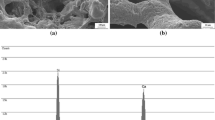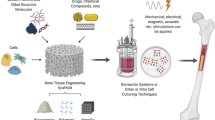Abstract
Bioactive glass scaffolds have been produced, which meet many of the criteria for an ideal scaffold for bone tissue engineering applications, by foaming sol-gel derived bioactive glasses. The scaffolds have a hierarchical pore structure that is very similar to that of cancellous bone. The degradation products of bioactive glasses have been found to stimulate the genes in osteoblasts. This effect has been found to be dose dependent. The addition of silver ions to bioactive glasses has also been investigated to produce glasses with bactericidal properties. This paper discusses how changes in the hierarchical pore structure affect the dissolution of the glass and therefore its bioactivity and rate of ion delivery and demonstrates that silver containing bioactive glass foam scaffolds can be synthesised. It was found that the rate of release of Si and Ca ions was more rapid for pore structures with a larger modal pore diameter, although the effect of tailoring the textural porosity on the rate of ion release was more pronounced. Bioactive glass scaffolds, containing 2 mol% silver, released silver ions at a rate that was similar to that which has previously been found to be bactericidal but not high enough to be cytotoxic to bone cells.
Similar content being viewed by others
References
L. L. HENCH and J. M. POLAK, Science 295 (2002) 1014.
J. E. DAVIES, “Bone Engineering”, (EM2 incorporated, Toronto, 2000).
R. LANGER and J. P. VACANTI, Science 260 (1993) 920.
H. OHGUSHI and A. I. CAPLAN, J. Biomed. Mater. Res. B. 48 (1999) 913.
T. TAKEZAWA, Biomaterials 24 (2003) 2267.
J. R. JONES, P. D. LEE and L. L. HENCH, Phil. Trans. R. Soc. A 364 (2006) 263.
L. L. HENCH, J. Am. Ceram. Soc. 74 (1991) 1487.
I. D. XYNOS, A. J. EDGAR, L. D. K. BUTTERY, L. L. HENCH and J. M. POLAK, J. Biomed. Mater. Res. 155 (2000) 151.
L. L. HENCH, R. J. SPLINTER, W. C. ALLEN and T. K. GREENLEE, J. Biomed. Mater. Res. 2 (1971) 117.
L. L. HENCH, J. Mat. Sci. Mater. Med. This Issue
H. YUAN, J. D. DE BRUIJN, X. ZHANG, C. A. VAN BLITTERSWIJK and K. DE GROOT J. Biomed, Mater. Res. 58 (2001) 270.
L. L. HENCH and J. K. WEST, Chem. Rev. 90 (1990) 33.
L.L. HENCH and W. VASCONCELOS, Ann. Rev. Mater. Sci. 20 (1990) 269.
R. LI, A. E. CLARK and L. L. HENCH, J. Appl. Biomat. 2 (1991) 231.
M. M. PEREIRA, A. E. CLARK and L. L. HENCH J. Biomed. Maters. Res. 28 (1994) 693.
N. J. COLEMAN and L. L. HENCH, Cer. Int. 26 (2000) 171.
P. SARAVANAPAVAN, J. R. JONES, R. S. PRYCE and L. L. HENCH, J. Biomed. Maters. Res. 66A (2003) 110.
J. R. JONES and L. L. HENCH, J. Biomed. Maters. Res. 68B (2004) 36.
P. SEPULVEDA, J. R. JONES and L. L. HENCH J. Biomed. Maters. Res. 61 (2002) 301.
M. BELLANTONE, N. J. COLEMAN and L. L. HENCH, J. Biomed. Mater. Res. 51 (2000) 484.
M. BELLANTONE, H. D. WILLIAMS and L. L. HENCH, Antim. Ag. Ch. (2002) 1940.
P. SEPULVEDA, J. R. JONES and L. L. HENCH, J. Biomed. Maters. Res. 59 (2002) 340.
J. E. GOUGH, J. R. JONES and L. L. HENCH, Biomaterials 25 (2004) 2039.
J. R JONES and L. L. HENCH, J. Mat. Sci. 38 (2003) 3783.
J. R JONES and L. L. HENCH, J. Biomed. Maters. Res. 68B (2004) 36.
J. R. JONES, L. M. EHRENFRIED and L. L. HENCH, Biomaterials 27 (2006) 964.
Implants for surgery–Hydroxyapatite–Part 1: Ceramic hydroxyapatite. BS ISO 13779-1:2000.
J. R. JONES, P. SEPULVEDA and L. L.HENCH. J. Biomed. Mater. Res. 58B (2001) 720.
S. R. STOCK, Int. Mat. Rev. 44 (1999) 141.
R. ATWOOD, J. R. JONES, P. LEE and L. L. HENCH, Scripta Mat. 51 (2004) 1029.
M. SHIRKHANZADEH and M. AZADEGAN, J. Mat. Sci. 9 (1998) 385.
PEREIRA, J. R. JONES, R. L.OREFICE and L. L. HENCH, J. Mat. Sci.: Mat. Med. 16 (2005) 1045.
Author information
Authors and Affiliations
Corresponding author
Rights and permissions
About this article
Cite this article
Jones, J.R., Ehrenfried, L.M., Saravanapavan, P. et al. Controlling ion release from bioactive glass foam scaffolds with antibacterial properties. J Mater Sci: Mater Med 17, 989–996 (2006). https://doi.org/10.1007/s10856-006-0434-x
Received:
Accepted:
Published:
Issue Date:
DOI: https://doi.org/10.1007/s10856-006-0434-x




